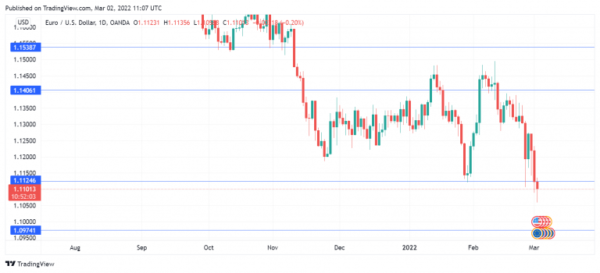The euro has fallen for three straight days and continues to lose ground on Wednesday. EUR/USD has dropped below the 1.11 line for the first time since May 2020, at the height of the first wave of Covid-19. It is looking ugly for the euro, which has sank 1.62% so far this week.
The intensified fighting which is raging in Ukraine has taken its toll on the euro. The eurozone is geographically close to the crisis and fears over shortages of gas and oil supplies due to a dependence on Russian supplies are weighing heavily on the currency. The US dollar is benefitting from the flight to safety by panicked investors, and the significant fall in US yields has also boosted the greenback.
Eurozone CPI jumps
Inflation in the eurozone continues to accelerate, much to the concern of the ECB. German CPI for February climbed 5.1% YoY, up from 4.9% a month earlier and matching the forecast. Eurozone CPI for February accelerated to 5.8%, above the estimate of 5.3% and ahead of the 5.1% gain in January.
The ECB holds a policy meeting on March 10th, but based on the most recent comments from ECB policy makers, the central bank will not tighten policy. These ECB members have been saying that the ECB should refrain from any significant shift in policy while the Ukraine crisis is unfolding. Germany’s 10-year bonds have fallen sharply, an indication that the markets expect central banks to be cautious and raise rates at a slower pace than had been expected before the Ukraine crisis.
The problem for central banks, especially the Fed and the BoE, is that inflation is red-hot and is unlikely to ease without higher rates to curb inflationary pressures. When it comes to monetary policy, the ECB will be walking a fine line between higher inflation and a full-blown military conflict in its backyard.
EUR/USD Technical
- There is resistance at 1.1406 and 1.1538
- EUR/USD is testing a major support level at 1.1100. Below, there is support at 1.0974



 Signal2forex.com - Best Forex robots and signals
Signal2forex.com - Best Forex robots and signals




